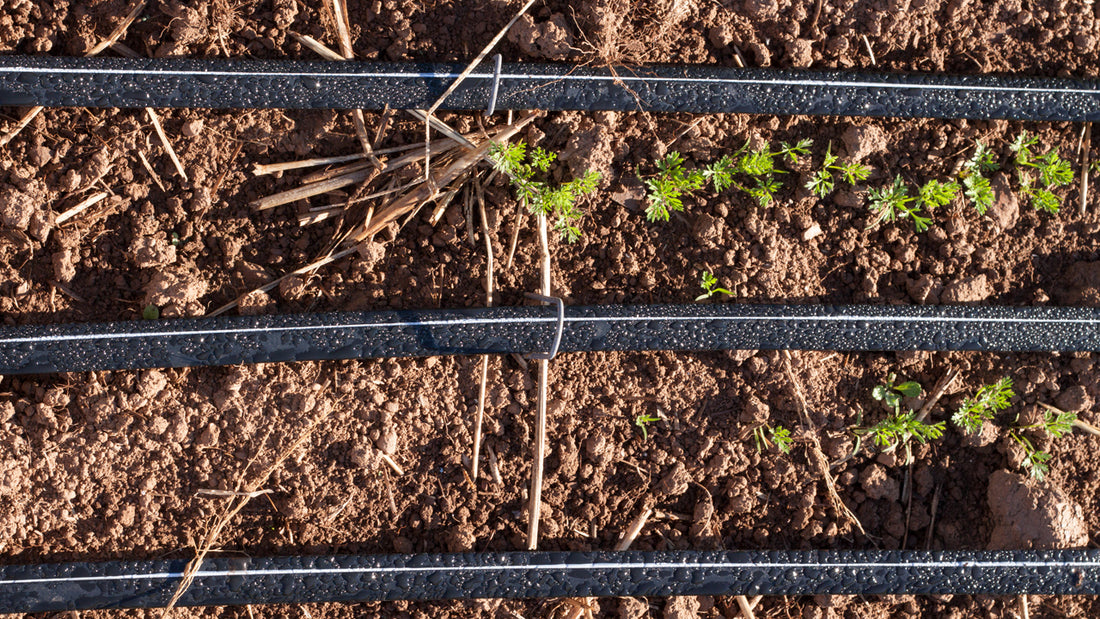Getting Started with Drip Irrigation
Take a minute to watch our video, where Tricia introduces several methods of drip irrigation.
There are lots of good reasons to use drip irrigation! Drip irrigation can lower your water bill, protect our water resources, and even increase your crop yield by applying deep water. If you bury the irrigation lines you'll thwart annual weeds too, which do not thrive in areas without ground-level water (near where they germinate).
Setting Up Your Water Source
Watch our video to see Tricia connecting her drip irrigation system to a spigot. (Note: the filter hook up no longer needs the brass adapters) The water hook-up steps are the same, no matter what kind of irrigation technology you'll be using in your planting beds. It's like the old song, "the knee bone's connected to the thigh bone." Screw the Y Connector onto the spigot and keep on attaching the parts in order:
- Y Connector with Shut Off
- Electronic Water Timer
- Vacuum Breaker
- Flushable Y Filter (no longer need the brass adapters)
- Pressure Regulator (the exact pressure regulator needed will depend on the type of drip irrigation you are installing)
Poly Tubing
Poly tubing (illustrated in blue in our diagrams) is the backbone of your drip irrigation system, moving water out to the delivery system of your choice.
Choose Your Drip Irrigation System
Soaker Hoses Distribute Water Uniformly
Do you want water seeping evenly along a line? If so, choose a soaker hose as your delivery system. Here's a diagram showing poly tubing and soaker hoses (illustrated in green) combined for irrigation. If you have hard water, consider installing a Calcium Filter to reduce clogs.
Emitterline for Meandering, Moderate WateringEmitterline (illustrated in tan) is your best bet if you want watering done at 12" intervals along a curving line, like for use around trees at the drip line. 1/2" emitter line can also be used in straight rows in the garden. Power-Loc fittings work with the 1/2" emitter line and you can use barb connectors for the 1/4" emitter line.
Drip Tape for Cost-Effective, Low-Pressure WaterUse Drip Tape (illustrated in red) when you want water at 8" intervals in straight lines. It's a popular choice for vegetable beds. Leave it on the surface, or bury it (to stymie the weeds). One of the advantages of Drip Tape is that the slits in its lines open during watering, then close again. You must put a pressure reducer (10 psi) for Drip Tape if you're using a higher pressure water source. If not, the tape will rupture and leak water.
Emitters & Microspray to Pinpoint WaterWould you like to have complete choice in the spacing of water intervals? Customize water delivery with emitters (illustrated in black) you place along lines. Or attach sprayers (illustrated in black) on riser tubes and stakes to saturate specific areas.
Fun Fact: Are you suffering from "Gizmophobia?"
"Gizmophobia" is author Robert Kourik's expression for those who fear the array of tubes and valves! His acclaimed book, Drip Irrigation for Every Landscape, is a model of clarity (and humor). It's like having an experienced friend walk you through designing and building the irrigation for your garden!
For more tips on setting up drip irrigation in raised beds and water conservation tips, please visit our Resource Center.
Have a great growing season with drip irrigation: water going to just the right places, on time, for less money and healthier plants!

